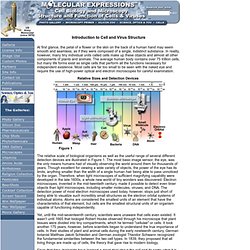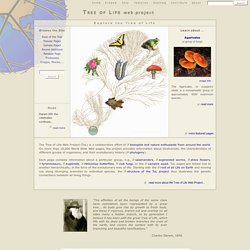

Learn.Genetics™ DiscoveR8 - News for Life Science. Molecular Expressions Cell Biology: Structure of Cells and Viruses. Introduction to Cell and Virus Structure At first glance, the petal of a flower or the skin on the back of a human hand may seem smooth and seamless, as if they were composed of a single, indistinct substance.

In reality, however, many tiny individual units called cells make up these objects and almost all other components of plants and animals. The average human body contains over 75 trillion cells, but many life forms exist as single cells that perform all the functions necessary for independent existence. Most cells are far too small to be seen with the naked eye and require the use of high-power optical and electron microscopes for careful examination. The relative scale of biological organisms as well as the useful range of several different detection devices are illustrated in Figure 1. Yet, until the mid-seventeenth century, scientists were unaware that cells even existed.
Questions or comments? Last modification: Thursday, May 12, 2005 at 11:18 AM Microscopes provided by: The Complete Work of Charles Darwin Online. Animal Diversity Web. Home of CELLS alive! Tree of Life Web Project. The Tree of Life Web Project (ToL) is a collaborative effort of biologists and nature enthusiasts from around the world.

On more than 10,000 World Wide Web pages, the project provides information about biodiversity, the characteristics of different groups of organisms, and their evolutionary history (phylogeny). Each page contains information about a particular group, e.g., salamanders, segmented worms, phlox flowers, tyrannosaurs, euglenids, Heliconius butterflies, club fungi, or the vampire squid. ToL pages are linked one to another hierarchically, in the form of the evolutionary tree of life. Starting with the root of all Life on Earth and moving out along diverging branches to individual species, the structure of the ToL project thus illustrates the genetic connections between all living things.
Encyclopedia of Life. Graphics Gallery from Access Excellence. Evolution Entrance. These exhibits trace evolutionary thought as it has developed over time, pausing to ponder the contributions of scientists and thinkers including Aristotle, Darwin, Wallace, and many others.

Explore the theory of evolution. Learn about the history of evolutionary thought. There are many other great places to look on-line for information about evolution. Here are a few of our favorites: — Visit Understanding Evolution, a new site launched in February 2004 to meet the needs of K-12 teachers. . — Browse the Talk Origins Archive, a rich source of information about evolution and the evolution/creation controversy. — Visit the National Center for Science Education website, a nationally-recognized clearinghouse for information and advice on teaching evolution in the classroom. MendelWeb Homepage 97.1. 3. La química de la herencia. ... y la genética molecular. por Teodora Zamudio “¿Y si tiene mi apariencia física y tu cerebro?”

Bernard Shaw a Isadora Duncan En la actualidad, la biología molecular suministra un amplio caudal de conocimiento acerca de los genes. Tal conocimiento podrá incrementarse o, incluso, modificarse a la luz de investigaciones futuras. La historia de la genética se desarrolló bajo la guía de estas preguntas, preguntas que sólo cobrarían sentido desde una interpretación realista del discurso científico. 3.1 El ADN nuclear. 3.1.1 La replicación del ADN. 3.1.2 La trascripción y la traducción del ADN. Genetic Origins from Cold Spring Harbor Laboratory. Understanding Genetics: Human Health and the Genome.
Try your luck at DNA Roulette.

Watch out, you might even learn something...Learn More See whether online genetic tests are right for youLearn More When Will Broccoli Taste Like Chocolate? Learn about our book! Learn More.